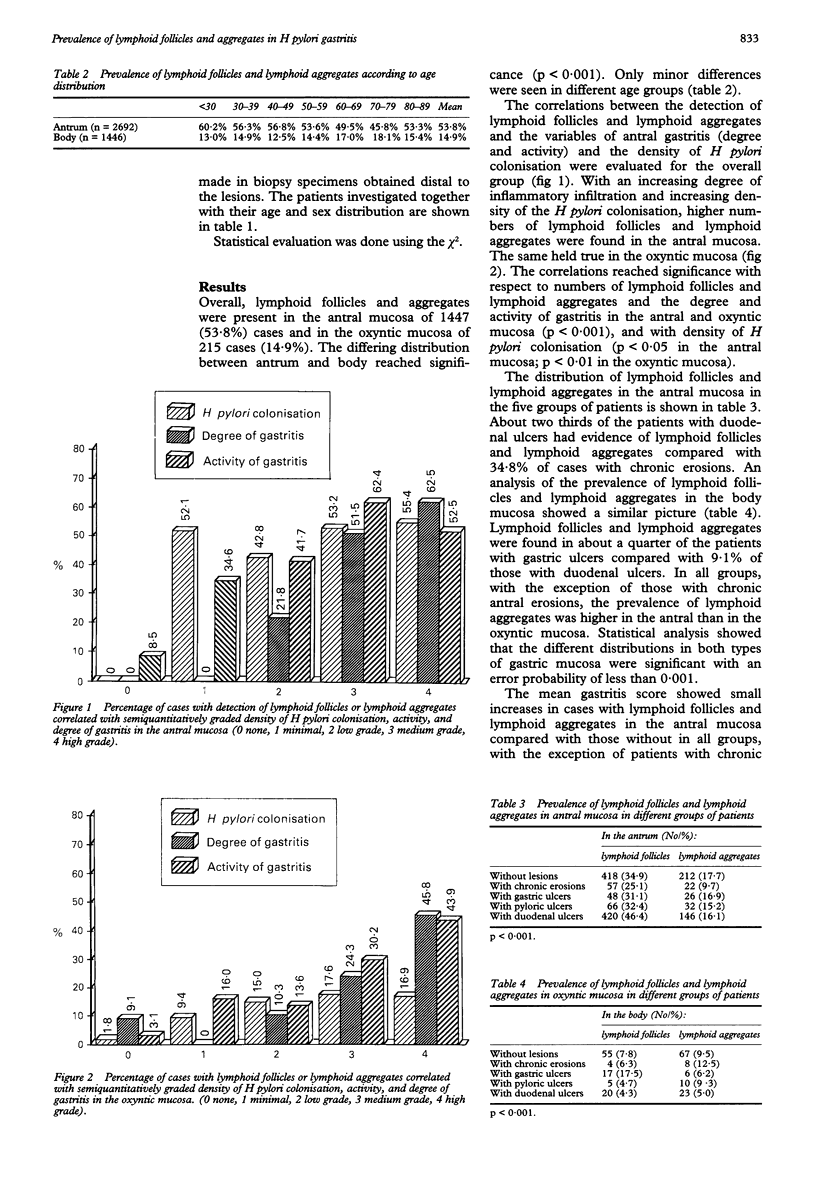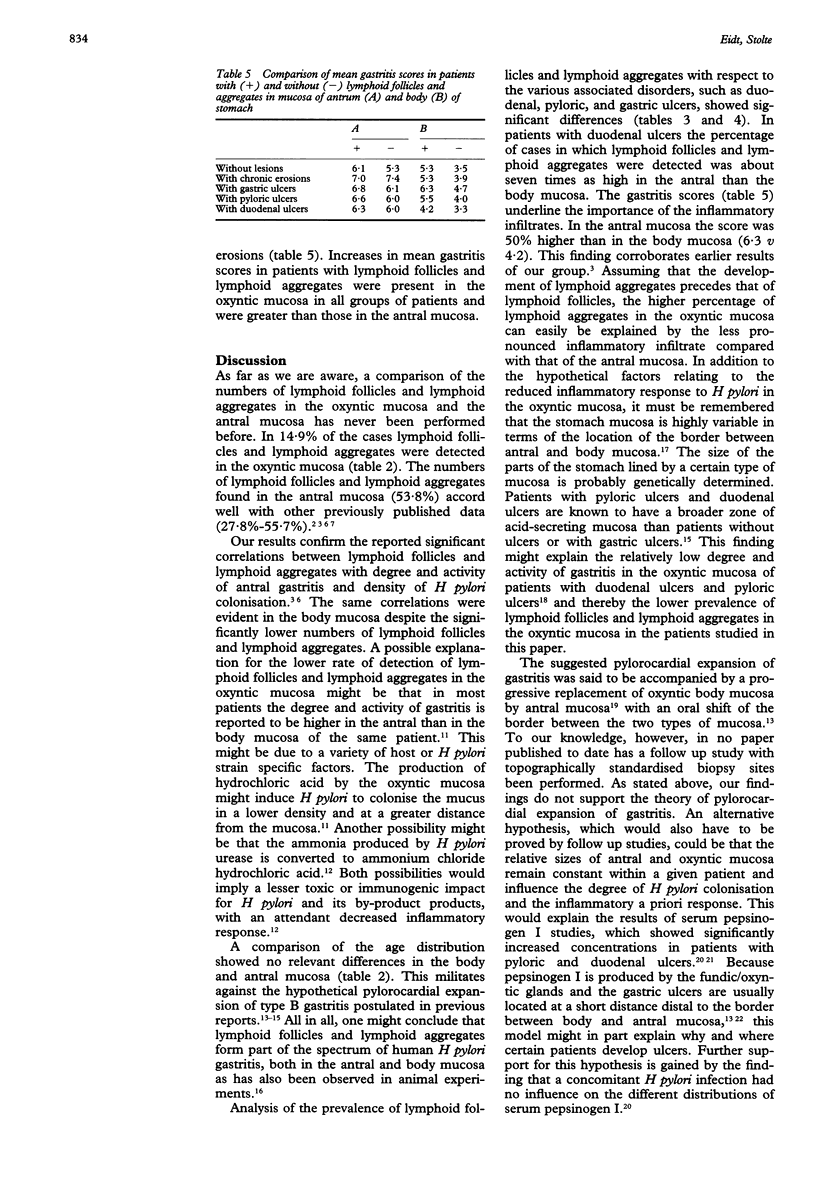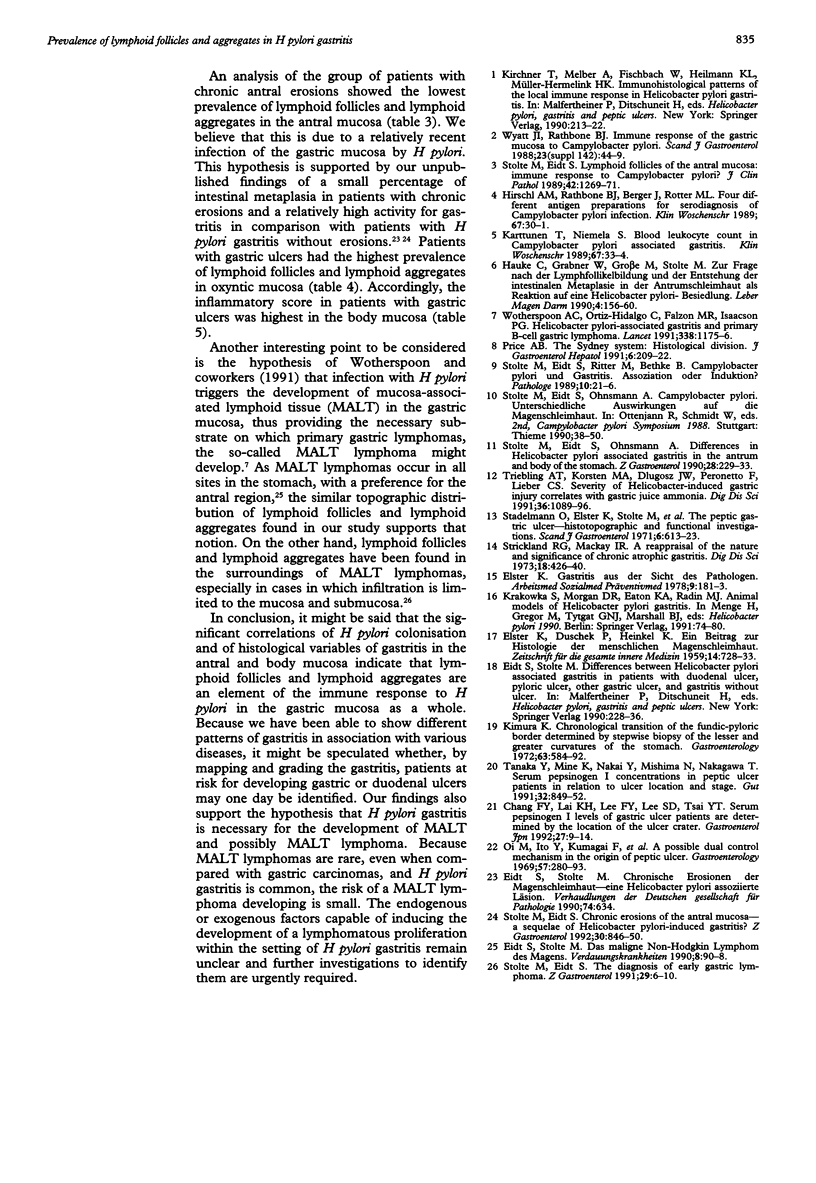Abstract
AIMS--To evaluate the prevalence of lymphoid follicles and aggregates in the antral and body mucosa in Helicobacter pylori gastritis and to assess if there were correlations with ulcers in the duodenum, pylorus, or stomach, and with chronic antral erosions. METHODS--Patients (n = 2692) with histologically confirmed H pylori antral gastritis were investigated. These comprised five groups: those with duodenal ulcers; those with pyloric ulcers; those with gastric ulcers; those with chronic erosions; and those with no associated lesions. In 1446 cases at least two additional biopsy specimens from the oxyntic mucosa were available. RESULTS--Lymphoid follicles and aggregates were found in 53.8% of cases in the antral mucosa compared with 14.8% in the oxyntic mucosa (p < 0.001). The various diseases showed significant differences in terms of the prevalence of follicles and aggregates: The highest numbers in the antral mucosa as well as the lowest in the oxyntic mucosa were found in patients with duodenal ulcers (60.5% and 9.2%, respectively). The highest numbers of follicles and aggregates in the oxyntic mucosa occurred in patients with gastric ulcers. CONCLUSIONS--The detection of lymphoid follicles and aggregates in oxyntic mucosa and the higher prevalence in antral mucosa fits well with the distribution of primary gastric lymphomas. This adds further weight to the notion that the development of follicles and aggregates, triggered by H pylori, might be an early precursor to gastric lymphoma. The differences between the groups investigated might be due to different strains of H pylori or differences in the respective sizes of antral and oxyntic mucosa.
Full text
PDF



Images in this article
Selected References
These references are in PubMed. This may not be the complete list of references from this article.
- Chang F. Y., Lai K. H., Wang T. F., Lee F. Y., Lee S. D., Tsai Y. T. Serum pepsinogen I levels of gastric ulcer patients are determined by the location of the ulcer crater. Gastroenterol Jpn. 1992 Feb;27(1):9–14. doi: 10.1007/BF02775058. [DOI] [PubMed] [Google Scholar]
- Kimura K. Chronological transition of the fundic-pyloric border determined by stepwise biopsy of the lesser and greater curvatures of the stomach. Gastroenterology. 1972 Oct;63(4):584–592. [PubMed] [Google Scholar]
- Oi M., Ito Y., Kumagai F., Yoshida K., Tanaka Y., Yoshikawa K., Miho O., Kijima M. A possible dual control mechanism in the origin of peptic ulcer. A study on ulcer location as affected by mucosa and musculature. Gastroenterology. 1969 Sep;57(3):280–293. [PubMed] [Google Scholar]
- Stolte M., Eidt S. Chronic erosions of the antral mucosa: a sequela of Helicobacter pylori-induced gastritis. Z Gastroenterol. 1992 Dec;30(12):846–850. [PubMed] [Google Scholar]
- Stolte M., Eidt S. Lymphoid follicles in antral mucosa: immune response to Campylobacter pylori? J Clin Pathol. 1989 Dec;42(12):1269–1271. doi: 10.1136/jcp.42.12.1269. [DOI] [PMC free article] [PubMed] [Google Scholar]
- Stolte M., Eidt S., Ohnsmann A. Differences in Helicobacter pylori associated gastritis in the antrum and body of the stomach. Z Gastroenterol. 1990 May;28(5):229–233. [PubMed] [Google Scholar]
- Stolte M., Eidt S., Ritter M., Bethke B. Campylobacter pylori und Gastritis. Assoziation oder Induktion? Pathologe. 1989 Jan;10(1):21–26. [PubMed] [Google Scholar]
- Stolte M., Eidt S. The diagnosis of early gastric lymphoma. Z Gastroenterol. 1991 Jan;29(1):6–10. [PubMed] [Google Scholar]
- Tanaka Y., Mine K., Nakai Y., Mishima N., Nakagawa T. Serum pepsinogen I concentrations in peptic ulcer patients in relation to ulcer location and stage. Gut. 1991 Aug;32(8):849–852. doi: 10.1136/gut.32.8.849. [DOI] [PMC free article] [PubMed] [Google Scholar]
- Wotherspoon A. C., Ortiz-Hidalgo C., Falzon M. R., Isaacson P. G. Helicobacter pylori-associated gastritis and primary B-cell gastric lymphoma. Lancet. 1991 Nov 9;338(8776):1175–1176. doi: 10.1016/0140-6736(91)92035-z. [DOI] [PubMed] [Google Scholar]
- Wyatt J. I., Rathbone B. J. Immune response of the gastric mucosa to Campylobacter pylori. Scand J Gastroenterol Suppl. 1988;142:44–49. [PubMed] [Google Scholar]




